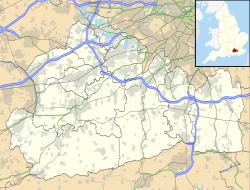History
The facilities on the 65-acre site were originally constructed in 1869 as a prison for disabled convicts known as the Woking Convict Invalid Prison. [1] [2] The prison had 613 inmates, both male and female, by 1870. [1] The buildings were converted into barracks capable of accommodating two infantry battalions in 1892 and initially became the home of the 2nd Battalion, the Royal West Surrey Regiment. [1] [3] The barracks were named after the Battle of Inkerman, a conflict during the Crimean War. [1]
The Royal Military Police, who had previously been based at a hutted camp at Mytchett, made it their depot in 1947. [1] It remained the location for all military police training until a new depot was established at Roussillon Barracks in Chichester in 1964. [4] [5] After the barracks closed in 1970, [6] the site was sold to the local council and developed for residential use. [1]
This page is based on this
Wikipedia article Text is available under the
CC BY-SA 4.0 license; additional terms may apply.
Images, videos and audio are available under their respective licenses.

